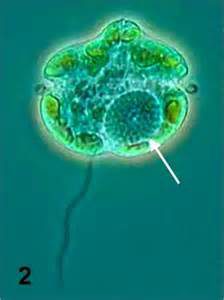There has been a lot of press across the Gulf coast concerning water-borne bacteria and health issues. From Blue-green algal blooms, to red tides, to “flesh-eating” bacteria (vibriosis). There have been a lot of questions on the topic at recent presentations, people are concerned. So, what is going on?

Photo: Randy Robinson
First, each of these organisms are naturally occurring in our environment. They are not new, we are just more aware of them now from reports. Some of these are bacteria, others a single-celled group called protists. Algae is a group term for them, but algae can include large species such as Sargassum and kelp. The ones we hear about are microscopic.
They are not plants, but rather “plant-like” in that they acquire nutrients, carbon dioxide, and sunlight to produce their food. Most reproduce asexually by simple cell division, but some can reproduce sexually. As with any creature, when resources are abundant, and the weather warm, they can reproduce very quickly. Also, as with any creature, an abundance of resources can increase their reproductive rate.
Excessive amounts of resources can trigger an “algal-bloom”. Blooms can contain anywhere from 100,000 to 1,000,000 cells per liter of water. They are visible, with water color changes and/or odors. Colors can be red, blue, green, or brown. These blooms can decrease sunlight reaching the bottom thus impacting submerged growing plants – such as seagrasses. They will eventually die and the decomposition by bacteria is oxygen-demanding which reduces the available dissolved oxygen for fish and fish kills can occur. These fish kills can be large, visible, smelly, and can impact tourism. It has been estimated that red tide alone can cost the state of Florida around $20,000,000/year.

Worst yet, some of these microbes release toxins, and when in large numbers (a bloom) the toxin level can be dangerous for fish, marine mammals, pets, livestock, and even humans. Their toxins can build up in filter feeding organisms, such as oysters, which will force the closure of shellfish harvesting and further impact the locally economy.
And then there are those who come in contact with Vibrio vulnificus or V. parahaemolyticus – the ones who cause what so called “flesh-eating” disease. It actually is not flesh-eating at all. These bacteria cannot eat intact flesh and tissue. They can however enter via open wounds and the infection can look pretty horrific. Another means of entry to the body is consuming raw shellfish that have collected the algae while feeding. As with most microbes, as the environment warms, and the days grow longer, their growth rate increases. Most cases of “vibriosis” occur in the summer months. Most people have little reaction to it. Some will develop a condition called “cellulitis”; a skin infection. However, for those with a suppressed immune system this can be life threatening. Conditions considered high risk include: those with liver disease, alcoholism, diabetes, hepatitis, hemochromatosis, stomach disorders, HIV/AIDS, cancer, long-term steroid use, and those taking acid-reflux or heartburn medications. Anyone with these conditions should not enter brackish waters during the warmer months (April through November) with open wounds and should not consume raw shellfish during these months.
Okay fine… they are naturally occurring… why am I hearing so much about cases now?
We are hearing a lot about blue-green algae and red tides from south Florida. Again, they are naturally occurring but the frequency of occurrence has increased in recent years. The governor now has a task force to look into this. The quick of it – they are being enhanced by us. Excessive nutrients from lawns, golf courses, agriculture, septic tanks, and more are entering local freshwater waterways. These are flowing towards Lake Okeechobee and being released from the lake into coastal waterways when weather (storms) dictate they need to be to avoid flooding of neighboring towns. This excessive of nutrients, combined with record warm temperatures, has increased the occurrence of blooms and fish kills. However, Microcystis (and others) that cause blue-green blooms prefer freshwater, and these issues are larger problems in those waters. There was a report of dog dying in a local freshwater creek and blue-green was suspected as the possible cause. The EPA sampled the creek and found Microcystis at concentrations of 1.09 µg/L; they issue health advisories when concentrations reach 8.0 µg/L. Though the actual cause of death of the dog was unknown, the concern did result in a “caution” being posted.

Image: University of Wisconsin
I do not know the situation with the gentleman who recently came in contact with Vibrio in Big Lagoon. I do know that in Florida, between 2008-2017, the number of cases of vibriosis was about 165/year. In 2017 it increased to 274/year. Florida cases involving Vibrio vulnificus were 50 in 2017 (with 11 fatalities) and there have been at least 10 so far in 2019. Between 2008-2017 52.8% of the cases contracted the bacteria through open wounds while in the water. 22.3% consumed raw shellfish, and 24.9% were unknown.
Either way, there have been an increase in reports, press, and concerns. There are several websites where you can get more information on any of these. Florida Sea Grant has two:
Harmful Algal Blooms Effecting Florida’s Coast
http://www.flseagrant.org/algae-blooms/.
Vibrio in Florida; Know the Facts
https://blogs.ifas.ufl.edu/brevardco/2019/08/06/vibrio-in-florida-know-the-facts/.
 1
1
